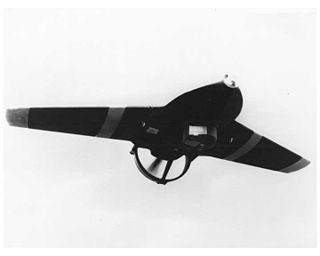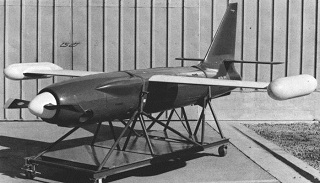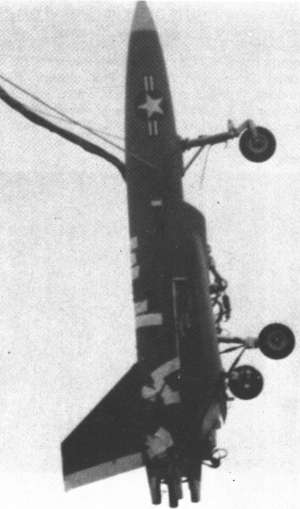Related Research Articles

Joint Regulation 4120.15E: Designating and Naming Military Aerospace Vehicles is the current system for designating all aircraft, helicopters, rockets, missiles, spacecraft, and other aerial vehicles in military use by the United States Armed Forces.
The Lockheed Senior Prom was a classified black project conducted by the United States Air Force in conjunction with the Lockheed Corporation's Skunk Works for the development and testing of a cruise missile using stealth technology. Based on the company's Have Blue demonstrator, the six Senior Prom vehicles proved successful in testing conducted at Area 51 in the late 1970s; despite this, the aircraft was not selected to enter production, and the program was terminated in the early 1980s.

The DRDO Nishant - is an unmanned aerial vehicle (UAV) developed by India's Aeronautical Development Establishment (ADE), a branch of Defence Research and Development Organisation (DRDO) for the Indian Armed Forces. The Nishant UAV is primarily tasked with intelligence gathering over enemy territory and also for reconnaissance, training, surveillance, target designation, artillery fire correction, damage assessment, ELINT and SIGINT. The UAV has an endurance of four hours and thirty minutes. Nishant has completed development phase and user trials.

The Lockheed MQM-105 Aquila (Eagle) was the first small battlefield drone developed in the United States during the 1970s to act as a target designator for the US Army.
The XMQ-17A ("SpyHawk") is an unmanned aerial vehicle built and developed by MTC Technologies which was intended to be used by the US Marine Corps in order to fulfill a need for an unmanned aerial reconnaissance capability at division level, or "Tier II". Launched from a trailer-mounted pneumatic launcher, the aircraft is powered by a single Honda GX-57 gasoline-fueled piston engine. The SpyHawk purchase was canceled in January 2008, after MTC Technologies was purchased by BAE Systems.

The Boeing Phantom Eye was a high altitude, long endurance (HALE) liquid hydrogen-powered unmanned aerial vehicle developed by Boeing Phantom Works. The aircraft was Boeing's proposal to meet the demand from the US military for unmanned drones designed to provide advanced intelligence and reconnaissance work, driven by the combat conditions in Afghanistan in particular. In August 2016, the Phantom Eye demonstrator was disassembled for display at the Air Force Flight Test Museum.

The Radioplane Q-1 was an American target drone, developed in the early 1950s for the United States Air Force by the Radioplane Company. Originally powered by a pulsejet engine, then later developed as an improved turbojet-powered aircraft, the Q-1 failed to win the favor of the USAF. However, the aircraft provided the basis of the GAM-67 Crossbow anti-radar missile.

The MQM-42 was a supersonic target drone developed by North American Aviation. Developed in two subvariants, Redhead and Roadrunner, it was used by the United States Army in the 1960s and 1970s.

The Fairchild BQ-3, also known as the Model 79, was an early expendable unmanned aerial vehicle – referred to at the time as an "assault drone" – developed by Fairchild Aircraft from the company's AT-21 Gunner advanced trainer during the Second World War for use by the United States Army Air Forces. Two examples of the type were built and flight-tested, but the progress of guided missiles rendered the assault drone quickly obsolete, and the type was not produced.

The Radioplane RP-77 was a small target drone missile, constructed largely of plastic materials, produced by the Radioplane division of the Northrop Corporation. Although the RP-77D was successfully tested by the United States Army, the decision was made not to procure the aircraft.

The McDonnell TD2D Katydid was a pulsejet-powered American target drone produced by McDonnell Aircraft that entered service with the United States Navy in 1942, and continued in use until the late 1940s.

The NSRDC XBQM-108A was an experimental VTOL unmanned aerial vehicle developed by the United States Navy during the 1970s. Although the XBQM-108A successfully conducted unmanned, tethered flight tests and the project was canceled before any free flights could be conducted.

The Globe KD6G Firefly is an American target drone, built by the Globe Aircraft Corporation for operation by the United States Navy during the 1950s and early 1960s.

The Radioplane XKD4R, known by the company designation RP-70, was an American target drone developed by the Radioplane Division of the Northrop Corporation. Although it was not produced in quantity, it was developed into the successful AQM-38.
The Aerojet SD-2 Overseer was an unmanned aerial vehicle developed by Aerojet General and Rheem Manufacturing Co. in the late 1950s for use by the United States Army. Built in limited numbers, it never saw operational service.

The Radioplane OQ-17 was a target drone produced by the Radioplane Company for the United States Army Air Forces and, as the TD4D/KDR Quail, the United States Navy. Suffering from an unreliable engine, the OQ-17 production run was cut short in favor of the OQ-19.

The Republic SD-3 Snooper was an early reconnaissance drone developed by Republic Aviation for the United States Army. It was evaluated by the Army Signal Corps in 1959, but did not enter operational service.
The Radioplane OQ-6 was a target drone developed by the Radioplane Company under the designation RP-14 and evaluated by the United States Army Air Forces for service use. A small number were procured, but major production contracts were cancelled by the end of World War II.
The Republic SD-4 Swallow was an early high-speed reconnaissance drone developed by Republic Aviation for the United States Army. Intended for use by the U.S. Army Signal Corps to target tactical ballistic missiles, it was cancelled before the first prototype could be completed, and did not see operational service.

The Fairchild SD-5 Osprey was an early high-speed reconnaissance drone developed by Fairchild Aircraft for the United States Army. Intended for use by the U.S. Army Signal Corps to target tactical ballistic missiles, it was cancelled before the first prototype could be completed, and did not see operational service.
References
Citations
Bibliography
- Francillon, Rene J. (1987). Lockheed Aircraft since 1913. Annapolis, MD: Naval Institute Press. ISBN 978-0-8702-1897-2.
- Munson, Kenneth (1988). World Unmanned Aircraft . London: Janes Information Group. ISBN 978-0-7106-0401-9.
- Jane's Weapons Systems 1979–1980. London: Jane's Information Group. 1979. Retrieved 2017-12-16.
- Parsch, Andreas (5 May 2004). "Lockheed Aequare". Directory of U.S. Military Rockets and Missiles, Appendix 4: Undesignated Vehicles. Designation-Systems. Retrieved 2017-12-16.